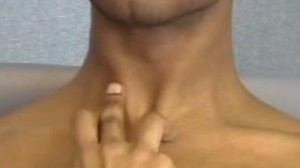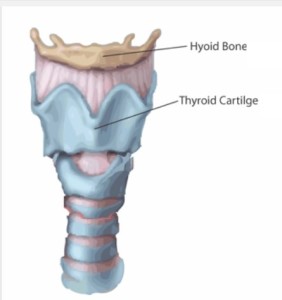The windpipe or the trachea is an important respiratory tube-like structure in the body. In normal adults, it is about 4 to 6 inches long and around 1 inch diametrically. It is located in the almost vertically in the middle of the neck anterior to the esophagus. It runs downwards at the back of the breastbone into the chest cavity and eventually connects the 2 bronchi to the larynx. In some people, the trachea may be located somewhat towards the right.
The tracheal membrane is supported by about 20 rings of cartilage which prevent the collapse of the structure. At the back, these rings are open and joined together via bands of muscles, which in turn facilitates the inhalation and exhalation processes by helping the trachea expand and contract.
The trachea also helps defend the respiratory system against the adverse effects of environmental allergens or irritants. The sensitive mucous membrane that lines the lining of the trachea triggers a coughing flex, which then causes the affected person to cough out unwanted matter that may have entered the body.
What is tracheal deviation?
Any movement or shift of the trachea towards the right or left from its normal position is considered as a tracheal deviation. It can only be confirmed by a physical examination and other diagnostic tests. The condition is also accompanied by external signs and symptoms.
The mid-section of the chest cavity has the mediastinum compartment and is home to major blood vessels and the heart. On the right and left sides, it is surrounded by the pleural cavity which houses the lungs. Tracheal deviation is caused due to any kind of movement of the mediastinum from its original position, especially that of the upper compartment. It may be noted that tracheal deviation is not a sign of an anomaly with only the trachea; it can be indicative of other underlying conditions as well.
Symptoms
Some of the signs and symptoms of tracheal deviation are listed below:
- Heart problems
- Tachycardia or increased rate of heart beats
- The jugular vein may suffer from distention. This is a not so common symptom; it may not occur particularly if a patient suffers from serious hypotension.
- Hypotension or low blood pressure
- Pain in chest
- Breathing problems
- Respiratory arrest
- Respiratory distress
- Asymmetrical expansion of the lungs
- Tachypnea or increased rate of respiration
- Reduced or lack of breathing sounds
- Adventitious breath sounds, i.e., crackles or wheezing
- Other anomalous breathing sounds which is usually not audible to the naked ear, but can be detected via a stethoscope.
- Dyspnea or breathing difficulties
- Coughing
- Other problems
- Fatigue
- Anxiety
- In rare cases, epigastric pain.
Tracheal deviation – causes
Tracheal deviation may occur due to a variety of causative factors. The trachea will usually shift from its normal position to an area which has comparatively higher negative pressure.
Some of the common causes of tracheal deviation are listed below:
- Tracheal deviation caused due to lung problems: When the lungs are diseased, the pleural cavity pressure may lower on one side, thereby causing the upper mediastinum to move towards the affected side, eventually causing tracheal deviation. Some common causative lung disease include:
- Pneumonectomy: It is a surgical procedure carried out as treatment for lung disorders such as lung cancer, etc. The surgery involves partial or complete removal of the lung.
- Pleural fibrosis: The condition is marked by thickening/hardening of the pleura, i.e., the chest cavity inner lining. It may occur due to chronic inflammation of the chest cavity wall and may later trigger calcification.
- Atelectasis: Also commonly known as a collapsed lung, atelectasis can occur due to some kind of blockage or obstruction which hampers the ability of the lungs to inflate sufficiently.
- Lung aplasia/agenesis: It is a congenital condition marked by absence of one of the lungs and/or its bronchus.
- The above listed diseases do not allow the pressure in the lungs to increase during inhalation or keep it low during exhalation. As the unaffected lung functions normally, the trachea will tend to move towards the disease side with the low lung pressure.
- Tracheal deviation caused due to pleural cavity problems: Diseases of the pleural cavity can increase the pressure on one side, thereby causing the mediastinum and subsequently the trachea to shift towards the disease pleural cavity with low pressure.
- Tumors: Tracheal deviation may be caused due to both cancerous and non-malignant tumors. Any large growth present in the bronchi, lungs, or pleural cavity can cause the trachea to shift towards one side.
- Pleural effusion: It is condition marked by fluid buildup in the pleural space, i.e., the area between the lungs and the chest wall. However, tracheal deviation may occur only if there is substantial or humungous accumulation of fluids in the pleural space.
- Pneumothorax: The condition is marked by partial or complete collapse of the lungs due to entry of air into the pleural space, which in turn compresses the lungs and prevents their expansion during breathing, thereby leading to pneumothorax, tracheal deviation, and other deadly conditions.
- Tracheal deviation in babies – Children up to the age of 5 years may usually experience tracheal deviation. This is not related to any underlying medical condition. It typically occurs if the neck is shorter than the trachea and the anomaly tends to resolve by itself as the infant grows.
- Other causes: Tracheal deviation may also occur due to lung cancer, tracheal tumor, retrosternal goiter, and lymphoma or other ailments that cause serious swelling or the lymph nodes in the neck.
Tracheal Deviation – Treatment
Tracheal deviation by itself does not cause any major health problems. However, the underlying causative conditions can be life-threatening. Treatment is thus dependent on diagnosing the underlying cause and then treating it as per standard medical therapies. A few common treatment options include:
- Needle thoracostomy: In this, a 14 to 16 gauge cannula fitted with a syringe is inserted into the second intercostal space. The trapped air is then aspirated into the syringe. The therapy is done blindly, hence risky, and may lead to some health complications.
- Chest drain placement: It is visible and hence comparatively safer method to remove the trapped air. The treatment involves placement of a tube on the pleura with a similar aspiration mechanism as needle thoracostomy.



Hey, I searched for this blog on Bing and just wanted to say thanks for the excellent read. I would have to agree with it, thank you again!
Automatic ad submitter – get continuous traffic from thousands of ads. Post your site now: https://urlday.cc/ukdq3
Definitely, what a great website and informative posts, I definitely will bookmark your site.All the Best!